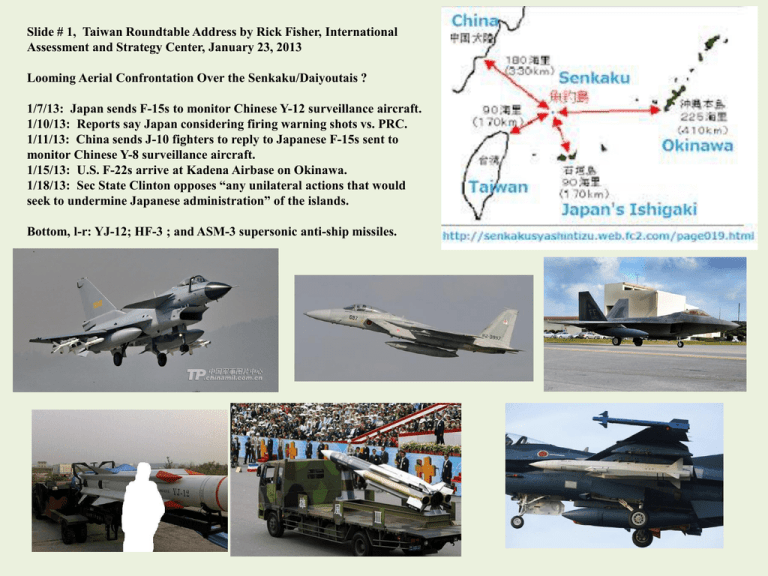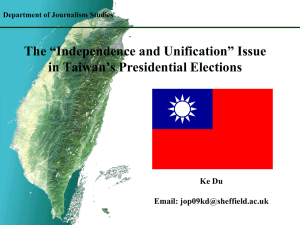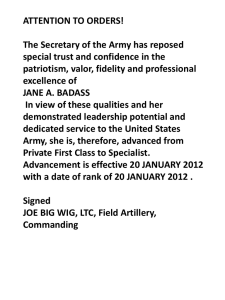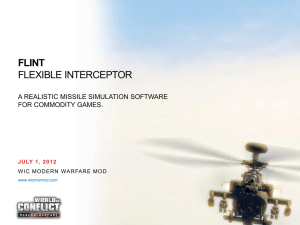Powerpoint
advertisement

Slide # 1, Taiwan Roundtable Address by Rick Fisher, International Assessment and Strategy Center, January 23, 2013 Looming Aerial Confrontation Over the Senkaku/Daiyoutais ? 1/7/13: Japan sends F-15s to monitor Chinese Y-12 surveillance aircraft. 1/10/13: Reports say Japan considering firing warning shots vs. PRC. 1/11/13: China sends J-10 fighters to reply to Japanese F-15s sent to monitor Chinese Y-8 surveillance aircraft. 1/15/13: U.S. F-22s arrive at Kadena Airbase on Okinawa. 1/18/13: Sec State Clinton opposes “any unilateral actions that would seek to undermine Japanese administration” of the islands. Bottom, l-r: YJ-12; HF-3 ; and ASM-3 supersonic anti-ship missiles. Slide # 2 Chinese Challenges Building Up Proxies China’s continued direct and indirect building of nuclear-armed proxies and radical states like North Korea, Iran and Pakistan increase the likelihood of nuclear terrorism and other conflicts that can tie down US forces. US strategy does not confront China’s central role in creating this threat. Global Power Projection Capabilities By 2025 + the PLA will have perhaps up to three Aircraft carrier battle groups, 6-12 amphibious battle groups and 100+ “Y-20” heavy air transports to take advantage of opportunities to Pivot vs the US. China may also be intending to establish Space Control. Prompt Global Strike or far more carrier battle groups? Nuclear Anxieties China revelation that it has completed up to 5,000km of tunnels as part of an Underground Great Wall has put into question general Western estimates that the PLA has 200-400 nuclear weapons. Former CoS of the Russian Missile Force General Yesin estimates the PLA has 1,300 to 1,800 deployed warheads or nuclear weapons, of a possible 3,000+ in stockpiles. What do we really know, and should the US be reducing its warheads below 1,550 ? Slide # 3: PLA Amphibious Army Available for Taiwan Ops Modernization and expansion of Army amphibious capabilities has been a key focus for PLA Army modernization. In the last decade an estimated 25 infantry and armored divisions and brigades have conducted some kind of amphibious training, or about a quarter of the total force. Leading amphibious would be followed by more numerous regular units. While the main focus in against Taiwan, there is ample capability to support Korean, South China Sea and Vietnam scenarios. Mechanization has seen two generations of new amphibious vehicles enter leading amphibious units in the last decade. Armored units include the new 3rd gen ZBD05 tank/IFV family and increasingly, the T-96 medium tank. 2nd gen T-63C amphib tank only now with 31st Group Army. There has also been a clear emphasis on gathering the requisite specialized engineering and beach breaching systems to support amphib ops. There is a distinct lack of formal amphibious lift that would have to be supplemented by ships taken up from trade (STUFT). Estimated PLA Army Leading And Follow-on Amphibious Capable Units Nanjing MR 1st Group Army 1st Amphibious Mechanized Infantry DIV 10th Armored DIV 9th Artillery DIV 3rd Motorized BDE 5th Army Aviation RGT st 31 Group Army 86th Amphibious Mechanized Infantry DIV Armored BDE 10th Army Aviation RGT th 12 Group Army 179th Special Landing BDE Guangzhou MR 42st Group Army 124th Amphibious Mechanized Infantry DIV 9th Armored BDE 163rd Motorized Infantry DIV 1st Artillery DIV 6th Army Aviation RGT 41st Group Army Jinan MR 54th Group Army 123rd Amphibious Mechanized Infantry DIV Armored BDE 132nd BDE (Hainan Island) 121 Motorized Infantry DIV 11th Armored DIV (?) 1st Army Aviation RGT Slide # 4: The Advantages of Missiles For Taiwan Taipei does not need to be sold on the advantages of having its own attack missile force. Since the late 1990s Taiwan has been developing the HF2E land attack cruise missile, the HF-3 supersonic anti-ship missile, and according to recent reports, the 1,200km range Yunfeng/Cloud Peak missile. The US has aided the development of Taiwan’s Ray Ting RT2000 artillery rocket system, which can fire a 240 mm rocket to 45km. This is similar to the early M26A1 version of the Lockheed-Martin M270 Multiple Launch Rocket System (MLRS). The U.S. has also sold Taiwan over 300 of the ship-launched124km range RGM-84 and the185km range air-launched AGM-84 Harpoon anti-ship missile. However, until recently the U.S. considered that longer-range missiles did not fall under the TRA definition of “defensive” weapons. But this is a semantic luxury as the PLA’s overall military advantages increase. MTCR compatible (300km range) missiles offer numerous asymmetric advantages: 1) cost much less than combat aircraft; 2) are difficult to detect and shoot down; 3) attacking missiles can overwhelm missile defenses at less expense; 4) can produce strategic results with tactical means—short range attack missiles can degrade the PLA’s SAM belt near Taiwan, allowing the Taiwan Air Force to fly more missions; and can be configured to carry scores of warheads to start to regain the advantages of “mass” versus the PLA; plus 5) they can also force the PLA to stage its invasion forces further from Taiwan, which will have the effect of greatly increasing the operational risks to these invasion force. The U.S. could opt to sell the 90km range version of the M270 artillery rocket, that would give the Taiwan Army far greater depth from which to counter PLA invasion forces. From Penghu this missile could cover many PLA SAM bases opposite Taiwan. In addition, the US could also sell the 300km range Lockheed-Martin MGM-140 ATACMS short-range ballistic missile (@ $1 million each). This missile could also be configured with many accurate submunitions that could be used to attack more SAM sites in Fujian Province or to counter invasion forces gathering in Fujian Province, and is survivable by virtue of its being land-based and highly maneuverable for a missile. Boeing’s concept for a Joint Air Breathing Multirole Missile (JABMM-on the right), offers to greatly reduce the cost for anti-air, anti-ship and ground attack missiles. Slide # 5: Missile Technology Taiwan Could Use: Sensor Fused Munitions If the U.S. opts not to sell Taiwan 300km range missiles or Taiwan opts to develop its own class of long range interdiction missiles, the U.S. can also consider selling Taiwan a new class of submunition that would greatly enhance the lethality and asymmetric advantage of its missiles: Sensor Fused Munitions (SFMs). SFMs offer the potential to give Taiwan the kind of “mass” that the PLA cannot defeat. In 2010 the U.S. decided to sell India over 20,000 Textron SFMs (500+ CBU-105 bombs with 40x SFMs each) for a cost of about $300 million, or less than the cost of 4x F-16C/D fighters. SFMs can be delivered by air-dropped bombs, artillery rockets, artillery shells, SRBMs, cruise missiles and unmanned aircraft. Developed by the U.S. in the 1980s and 1990s (and by Russia at the same time, and then by the PRC in this last decade), SFMs are small air-delivered projectiles that combine a “smart” sensor (laser , infrared, millimeter wave radar) able to find a target and its heat source, and then fire an explosively formed metal disc, copper or tantalum, at a high supersonic speed so that it can slice through a tank engine. If accurately placed a SFM could also disable a ship. The only defense against this weapon is to attack its carrying platform in the air or on the ground. Defeating launched SFM munitions would require a laser-based system that may not emerge for many years. The PLA’s SFM program was led by Yang Shaoqing, a 1984 engineering graduate of Texas A&M University (picture on bottom right). 20,000 SFMs would have the potential to destroy most of a 1,000+ ship PLA invasion fleet and most of the heavy armored vehicles that would succeed in landing on Taiwan. Would such a capability then deter a PLA attack for many years into the future? Slide # 6: US Options To Deter China In The Medium Term If the U.S. is going to continue to deter China, there must be consideration of not just the adequate funding of currently planned force and modernization levels, but there must also be consideration of significant new capabilities. But in doing so, the U.S. must also consider the value of current policies of restraint, such has its adherence to the INF Treaty, and restrictions on the sale of new weapons systems and also what it sells to Taiwan. But by significantly raising the cost of aggression it is possible to show Beijing the advantages of wider negotiated regimes of assurance. 1. New Regional Sensor Network A network of long-range APAR and OTH radar, with inputs from satellites and ELINT/SIGINT , that due to its central location would also include Taiwan, could potentially give network contributors a total view of most observable PLA activities. This enhances deterrence by providing warning and some assurance of sensor coverage in case of attack. 2. New intermediate-to-short range ballistic missiles The PLA’s ever increasing arsenal of theater missiles has made reliance on “anti-missiles” insufficient. Consistent with the emphasis on “payloads,” there is now a need for a new U.S. and Allied network of intermediate-to-short range ballistic missiles that can assure significant destruction of the PLA Navy, PLA invasion forces, space, and critical coastal region targets. Initially this should be a non-nuclear armed missile network.











